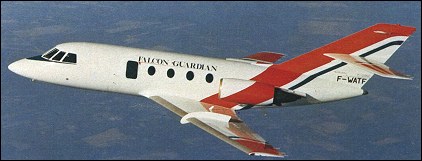 |
Dassault Mystere-Falcon 20/2001963 |  |
| EXECUTIVE TRANSPORT | Virtual Aircraft Museum / France / Dassault |
 |
Development of a light twin-turbojet executive transport was initiated by Dassault in conjunction with Aerospatiale (then Sud-Aviation), with construction of the prototype starting in January 1962. A cantilever low-wing monoplane with swept wings and tail surfaces, a circular-section fuselage and retractable tricycle landing gear, the prototype had a fuselage built by Dassault and wings and tail unit by Sud-Aviation. However, for production aircraft Dassault builds the wings and Aerospatiale the fuselages and tail units. First flown on 4 May 1963, and at the time powered by two 1497kg thrust Pratt & Whitney JTF12A-8 turbo-jets pod-mounted one on each side of the rear fuselage, the new aircraft was identified as the Dassault Mystere-Falcon 20 (Mystere in France, and Falcon for export sales). It was re-engined subsequently with General Electric CF700 turbofans, which became the standard powerplant. Following certification the Business Jets Division of Pan American World Airways (now known as Falcon Jet Corporation) became interested in this aircraft for sale in North America, where they were marketed under the name Fan Jet Falcon.The Mystere-Falcon 20 found employment for both civil and military use with orders approaching 500. The first production aircraft made its maiden flight on 1 January 1965 and this initial series became identified as the Standard Falcon 20. From this was developed a version with increased fuel capacity, available as the Falcon 20C with the same 1871kg thrust General Electric CF700-2C powerplant as the Standard Falcon, or as the Falcon 20D with the more powerful CF700-2D with a thrust rating of 1928kg. The introduction of 2041kg thrust CF700-2D-2 engines resulted in a version designated Falcon 20E, and the addition of high-lift devices to improve take-off and landing performance and a further increase in fuel capacity were identifying features of the Falcon 20F. Development of an improved Falcon 20G was initiated and this was offered by Falcon Jet Corporation to meet a US Coast Guard requirement for a medium-range surveillance aircraft. A contract for 41 aircraft, designated HU-25 Guardian, was awarded in 1977. Basically similar to the Falcon 20F, they differed in having airframe modifications required to accommodate varying role equipment, plus the installation of 2512kg thrust Garrett ATF 3-6-2C turbofan engines. In USCG service the HU-25A is used in the search and rescue role, HU-25B is the pollution control version, and the FLIR-equipped HU-25C modified for the drug interdiction role using a Westinghouse APG-66 search radar. Most recent development is the Falcon 200 which replaced the Falcon 20F on the production line in 1983, after 473 Falcon 20s had been delivered. Originally designated Falcon 20H the prototype 200, fitted with less powerful 2360kg thrust ATF 3-6A-4C engines, bigger fuel tanks in the rear fuselage, some systems' changes and redesigned wingroot fairings, flew for the first time on 30 April 1980. Announced at the 1981 Paris Air Salon the Falcon 200 was certificated by the DGAC on 21 June 1981 and deliveries began in 1982. By 1989 35 had been delivered to 11 countries. The maritime patrol and enforcement version of the Falcon 200 is marketed as the Gardian 2, and has a Thomson-CSF Varan search radar, two Exocet sea-skimming air to surface missiles mounted on underwing pylons, electronic surveillance and countermeasures equipment and target-towing capability. Five are in service with the French navy.
|  COMPANY PROFILE | ||||||||||||||||||||||||||||||||||||||||||||||||||||||||||||
 |

|


Does the 200 and the Falcon 50 wing slats is the same or not? The cockpit window looks like the same.
reply